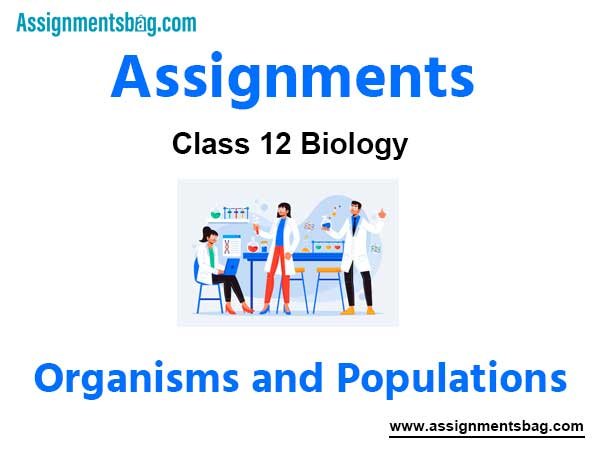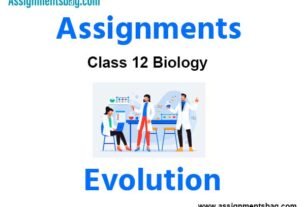Please refer to Assignments Class 12 Biology Organisms and Populations Chapter 13 with solved questions and answers. We have provided Class 12 Biology Assignments for all chapters on our website. These problems and solutions for Chapter 13 Organisms and Populations Class 12 Biology have been prepared as per the latest syllabus and books issued for the current academic year. Learn these solved important questions to get more marks in your class tests and examinations.
Organisms and Populations Assignments Class 12 Biology
Question. At organismic level which type of ecology exists
(a) Synecology
(b) Physiological ecology
(c) Behavioural ecology
(d) Systematic ecology
Answer
B
Question. Which of the following match is incorrect for commensalism interaction?
(a) Epiphytes on trees
(b) Egrets with grazing cattles
(c) Hermit crab and sea anemone
(d) Sea anemone and clown fish
Answer
C
Question. Formation of different kind of biomes depends on
(a) Light
(b) Temperature
(c) Precipitation
(d) Both 2 and 3
Answer
D
Question. Regional and local variation within each biome lead to formation of –
(a) Climate
(b) Weather
(c) Habitat
(d) Niche
Answer
C
Question. During interaction between sea anemone and clown fish, which get benefitted :-
(a) Sea anemone only
(b) Clown fish only
(c) Both
(d) Neither 1 nor 2
Answer
B
Question. Which of the following is not an example of coevolution?
(a) Orchid and Bee
(b) Opuntia and Cactophagous moth
(c) Yucca and Pronuba
(d) Wasp and Fig
Answer
B
Question. What is / are key elements that leads to so much variation in the physical and chemical conditions of different habitats?
(a) Temperature
(b) Water and light
(c) Soil
(d) All above
Answer
D
Question. What is the salinity of hypersaline lagoons?
(a) 5 ppt
(b) 30-35 ppt
(c) More than 100 ppt
(d) Less than 50 ppt
Answer
C
Question. Among the following algae that inhabit the sea, which is likely to be found in the deepest water?
(a) Red algae
(b) Brown algae
(c) Green algae
(d) Golden brown algae
Answer
A
Question. Percolation and water holding capacity of soil does not depend on –
(a) Soil composition
(b) Biota
(c) Size of grains
(d) Aggregation
Answer
B
Question. Which of the following is main reason for non occurence of small size conformers ?
(a) Karyoplasmic index
(b) Area : volume ratio
(c) Basal metabolism
(d) All the above
Answer
B
Question. Shortening of ears, limbs and other extremeties of mammals so that heat loss can be minimise, is associated with
(a) Allen’s rule
(b) Bergeman’s rule
(c) Jordan’s rule
(d) Rensch’s rule
Answer
B
Question. Which of the following mean was used by warblers to avoid competition and coexist
(a) Difference in foraging activities
(b) Habitat fragmentation
(c) Competitive release
(d) All of these
Answer
A
Question. Which of the following is not an adaptation of parasites for assurance of parasite host interaction
(a) Loss of sensory organs
(b) Presence of adhesive organs
(c) Loss of digestive system
(d) Low reproductive potential
Answer
D
Question. Altitude sickness can be seen at which specific height ?
(a) < 3500 m
(b) > 3500 m
(c) 5300 m
(d) < 530 m
Answer
B
Question. Which of the following is not an adaptation for altitude sickness ?
(a) Increase in red blood cell production
(b) Decrease in binding capacity of oxygen with haemoglobin
(c) Increased breathing rate
(d) Increased heart palpitations
Answer
D
Statement Type Questions
Question. Consider the following statements (A) – (D) each with one or two blanks.
A. Lichens represent an intimate (i) relationship between a fungus and (ii) .
B. The (iii) are associations between fungi and the roots of higher plants.
C. Plants need the help of (iv) for pollinating their flowers and dispersing their seeds.
D. The (v) pollinates the fig inflorescence while searching for suitable egg – laying sites.
Which one of the following options, gives the correct fill ups for the respective blank numbers from (i) – (v) in the statements?
(a) (i) Parasitic; (ii) – Cyanobacteria; (iii) – Mycorrhizae; (iv) – Wind; (v) – Bee
(b) (i) Mutualistic; (ii) – Cyanobacteria; (iii) – Mycorrhizae; (iv) – Animals; (v) Wasp
(c) (i) Parasitic; (ii) – Cyanobacteria; (iii) – Mycorrhizae; (iv) – Insect; (v) Bumblebees
(d) (i) Mutualistic; (ii) – Cyanobacteria; (iii) – Lichen; (iv) – Wind; (v) Wasp
Answer
B
Question. Which of the following statement is incorrect ?
(a) Habitat includes both biotic and abiotic factors.
(b) Abiotic and biotic components interact constantly with each other.
(c) Abiotic components alone can characterize the habitat of an organism.
(d) Major abiotic factors includes temperature, water, light and soil.
Answer
C
Question. Read the following statements (i to v) and answer the question.
(i) Temperature progressively decreases from pole to equator.
(ii) Our intestine is a unique habitat for hundreds of species of microbes.
(iii) Average temperature exceeds 100°C in thermal springs and hydrothermal vents.
(iv) In polar areas and high altitudes temperature goes to 70°C.
(v) Temperature goes to > 50°C in tropical desert in summer.
How many of the above statements are incorrect?
(a) (i), (ii), (iii)
(b) (i), (iv)
(c) (ii), (iv), (v)
(d) (iii), (iv)
Answer
B
Question. Which of the following statement is false?
(a) Regulators are organisms that are able to maintain homeostasis by physiological means or sometimes
by behavioural means.
(b) All birds and mammals, and very few lower vertebrates and invertebrates are capable of
osmoregulation and thermoregulation.
(c) Sweating and shivering are the means of thermoregulation by human.
(d) Plants are capable of thermoregulation.
Answer
D
Question. Identify the incorrect statement
(i) Thermoregulation energetically least expensive process for many organisms like shrews and humming birds.
(ii) 99% animals and nearly all plants cannot maintain their constant internal environment.
(iii) During the course of evolution, the costs and heights of maintaining a constant internal environment are discarded.
(iv) In aquatic animals, the osmotic concentration of the body fluids change with that of the ambient water osmotic concentration.
(a) (i) and (ii)
(b) (iii) and (iv)
(c) (i) and (iii)
(d) (ii) and (iii)
Answer
C
Question. Which statement explains the concept of Allen’s rule?
(a) Aquatic mammals have blubber as insulator.
(b) Mammals of colder climate have shorter ears and limbs.
(c) Mammals of humid and warmer region have more melanin in their skin.
(d) The bears undergoes hibernation during winter.
Answer
B
Question. Given below are some examples associated with a type of adaptation.
(i) Basking by desert lizards in sun.
(ii) Hiding in burrows by some animals.
(iii) Wearing of woolen clothes.
(iv) Thermal gaping
(a) Scansorial adaptation
(b) Cursorial adaptation
(c) Biochemical adaptation
(d) Behavioural adaptation
Answer
D
Question. Which of the following statement is incorrect regarding predators?
(a) It keeps prey population under control.
(b) It helps in maintaining species diversity.
(c) It reduces intensity of competition among competing prey species.
(d) Predator in nature are prudent because they do not exploit their prey.
Answer
D
Question. Which of the following is an incorrect statement?
(a) The human liver fluke depends on two intermediate hosts to complete its life cycle.
(b) The malarial parasite needs vector (mosquito to spread to other host).
(c) Parasites that feed on external surface of the host organism are called endoparasites.
(d) Cuscuta derives its nutrition from the host plant which it parasitises.
Answer
C
Assertion/Reason Type Questions
In the following questions, a statement of Assertion is followed by a statement of Reason.
(a) If both Assertion and Reason are true and the Reason is the correct explanation of the Assertion.
(b) If both Assertion and Reason are true but the Reason is not the correct explanation of the Assertion.
(c) If Assertion is true but Reason is false.
(d) If both Assertion and Reason are false.
Question. Assertion : In sigmoid growth curve, population finally stabilizes itself.
Reason : Finally, the death rate increases than the birth rate.
Answer
C
Question. Assertion : Predation is a type of interspecific interaction with a strategy based on feeding.
Reason : A stable population is maintained through time by the populations of predator and their prey and rarely one population becomes abundant or scarce.
Answer
A
Question. Assertion : Cold blooded animals do not have fat layer.
Reason : Cold blooded animals use their fat for metabolic process during hibernation.
Answer
A
Matching Type Questions
Question. Match the following
| Population | Example |
| A. Predation | I. Cuscuta and hedge plants |
| B. Commensalism | II. Balanus and Chathamalus |
| C. Parasitism | III. Cactus and moth |
| D. Competition | IV. Orchid and mango |
(a) A – III, B – IV, C – I, D – II
(b) A – IV, B – III, C – II, D – I
(c) A – I, B – III, C – II, D – IV
(d) A – III, B – IV, C – II, D – I
Answer
A
Diagram Type Questions
Question. The given figure flows biome distribution with respect to annual temperature and precipitation. In this few parts are marked as A, B & C. Mark the correct identification from the following picture.

| A | B | C |
| (a) Tropical forest | Temperate forest | Coniferous forest |
| (b) Temperate forest | Tropical forest | Coniferous forest |
| (c) Temperate forest | Coniferous forest | Tropical forest |
| (d) Coniferous forest | Tropical forest | Temperate forest |
Answer
A
Question. What type of human population is represented by the given age pyramid?

(a) Expanding population
(b) Vanishing population
(c) Stable population
(d) Declining population
Answer
D
Question. The density of a population in a given habitat during a given period, fluctuates due to changes in four basic processes On this basis choose the correct option to fill up A and B boxes in the given diagram.

(a) A = Natality + Immigration, B = Mortality + Emigration
(b) A = Natality + Mortality, B = Immigration + Emigration
(c) A = Birth rate + Death rate, B = Mortality + Emigration
(d) A = Natality + Emigration, B = Mortality + Immigration
Answer
A
Question. Study the population growth curves given below.

Which options is the best for curve (i) and (ii) ?

Answer
B
Critical Thinking Questions
Question. Which one of the following do not account for the formation of major biomes?
(a) Annual variation in intensity of temperature.
(b) Annual variation in duration of temperature.
(c) Annual variation in precipitation.
(d) Annual variation in texture of soil.
Answer
D
Question. Factors that are important for aquatic organisms include
(a) chemical composition of water
(b) pH of water
(c) spectral quality of solar radiation
(d) both (a) and (b)
Answer
D
Question. To a large extent the vegetation in any area is determined by
(a) temperature and pH.
(b) pH, mineral composition and light.
(c) pH, mineral composition and topography.
(d) types of minerals in soil.
Answer
C
Question. Very small animals are rarely found in polar regions because
(a) they have a smaller surface area relative to their volume.
(b) they have a larger volume relative to their surface area.
(c) they have smaller metabolic rate.
(d) they have a larger surface area relative to their volume.
Answer
D
Question. Many tribes living in the high altitude of Himalayas have a
(a) higher WBC count than people living in the plains.
(b) lower WBC count than people living in the plains.
(c) higher RBC count than people living in the plains.
(d) lower RBC count than people living in the plains.
Answer
C
Question. Natural selection operates to evolve the desired tracts at
(a) cellular level
(b) species level
(c) community level
(d) population level
Answer
D
Question. If 4 individuals in a laboratory population of 40 fruitflies died during a specified time interval (i.e., a week), the death rate in the population during that period is
(a) 1
(b) 0.1
(c) 0.01
(d) 0.4
Answer
B
Question. The age structure of a population influences population growth because
(a) younger females have more offsprings than do older females.
(b) different age groups have different reproductive capabilities.
(c) the more individuals that are immature the slower the population will grow.
(d) a shorter generation time results in slower population growth.
Answer
B
Question. The two basic processes which contribute to a increase in population density are
(a) mortality and immigration
(b) natality and immigration
(c) mortality and emigration
(d) mortality and emigration
Answer
B
Question. Assume that you have been studying a population of cattails at the edge of a pond. After 10 years of observations, you notice that the population has remained steady. What is the most likely explanation?
(a) The birth rate and death rate are both increasing at the same rate.
(b) The pond is drying up.
(c) The carrying capacity of pond has been reached.
(d) Nutrients levels in pond are fluctuating.
Answer
C
Question. In exponential growth, the increase or decrease in population size during a unit period is
(a) (B + I ) – (D + E)
(b) (b + d) – N
(c) N × (b – d)
(d) r + N
Answer
C
Question. Which of the following adaptation do not lessen the impact of predation?
(a) Some species of insects and frogs are camouflaged.
(b) Some animals are poisonous.
(c) Monarch butterfly is highly distasteful due to having certain chemical in their bodies.
(d) Different feeding habits of finches.
Answer
D
Question. The Abingdon tortoise in Galapagos Islands became extinct within a decade after goats were introduced on the island. This is apparently due to
(a) lower intrinsic rate of goat.
(b) the greater browsing efficiency of the goats.
(c) limiting resource.
(d) superiority of the goat.’
Answer
B



